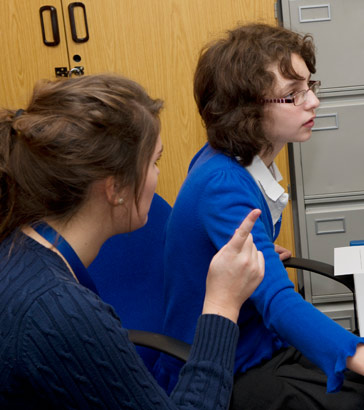
The general legal principle governing assessments is that they should be:
- Needs-led: they should not be decided according to the services that are available;
- Outcomes focused: what happens should enhance specific areas of the child's/young person's daily experiences to enable desired long term outcomes to be met.
The approach should address children's/young people’s needs holistically, taking into consideration their educational, religious and cultural needs (Contact a Family, 2014)
While assessment should follow promptly after a request for one, or an identification of need, it is not a one-off event; best practice ensures a continuous process.

An accurate picture of a child's/young person's needs is essential to making appropriate provision. The more complex their needs are, the greater the number of services that may require an assessment to be undertaken.
As a result, children/young people and their families have often been subjected to excessive numbers of repetitive assessment interviews leading to high levels of stress and personal cost. Inter-agency working can address this.
Under the Children Act 1989, various assessments can be combined, so one assessment may fulfil criteria for different agencies under more than one statute. For example, local social care and education departments, assessing under the Chronically Sick and Disabled Persons Act 1970 and the Children and Families Act 2014 respectively, can work together (Contact a Family, 2014).
The 0-25 SEND Code of Practice (2014, sections 3.24, 3.37) directs education, health and social care agencies to consider how an integrated approach can best support the family resilience and how they will align their provision for special educational needs/disabilities strategically and operationally (eg. through Early Help), sharing costs where appropriate.

Changes in policy and legislation have sought to create multi-agency processes to avoid multiple agencies each carrying out independent assessments. Two examples are:
- The new special educational needs framework – comprising the Children and Families Act 2014 (Part 3), the 0-25 SEND Code of Practice (2015) and associated regulations – together with the Care Act 2014, aim to enable different agencies to work collaboratively with families in relation to children and young people’s educational and related needs.
- The Children Act 2004 (section 11) and its related statutory inter-agency guidance – Working Together to Safeguard Children (HM Government, 2013) – requires local authority children's services, health services and other public agencies to work together to ensure that all their functions and actions safeguard and promote the welfare of children/young people. (Working Together (HM Government, 2013) has replaced the original Children Act 1989 guidance – Framework for Assessing Children in Need and their Families (2000) – and an earlier edition of Working Together (Department for Children, Schools and Families, 2009)).

Working Together to Safeguard Children (HM Government, 2013) describes the 'Early Help' Assessment, and promotes its use as a common inter-agency, single assessment framework.
In many local authorities, the Common Assessment Framework forms, or acts as a foundation for, the 'Early Help' assessment. Click here to read The Common Assessment Framework for Children and Young People: A guide for practitioners (Children's Workforce Development Council, 2009).
The diagram below shows the different focus areas for assessment (HM Government, 2013).
'Early Help' is part of an inter-agency safeguarding and wellbeing system. Under the Children Act 2004, professionals are charged with identifying children and families showing signs of needing 'early help', including children/young people with special educational needs/disabilities.
'Early Help means providing support as soon as a problem emerges, at any point
in a child's life, from the foundation years through to the teenage years. Providing
Early Help is more effective in promoting the welfare of children than reacting later.'
(Working Together to Safeguard Children; HM Government, 2013)
When concerns about a young person/family involve more than one statutory agency, the Early Help Assessment must be used collaboratively by all professionals at an early stage to safeguard the health and welfare and improve long term outcomes for children and young people, including hard to reach groups.
(Contact a Family, 2014; Local Government Association, 2014a; Surrey Safeguarding Children Board, 2014)
For further information, read:

Working Together to Safeguard Families (HM Government, 2013) advises that professionals should, in particular, be alert to the potential need for early help for a child who:
- Is disabled and has specific additional needs;
- Has special educational needs;
- Is a young carer;
- Is showing signs of engaging in anti-social or criminal behaviour;
- Is in challenging family circumstances for the child, such as adult substance abuse, mental health difficulties, domestic violence; and/or
- Is showing early signs of abuse and/or neglect.
Good 'Early Help' assessments enable professionals to understand whether a child has needs relating to their care or a disability and/or is suffering, or is likely to suffer, significant harm. The specific needs of disabled children should be given sufficient recognition and priority in the assessment process (HM Government, 2013).

Disabled children are more likely than their non-disabled peers to experience:
- Lower educational attainment;
- Poorer access to health services;
- Poorer health outcomes;
- More difficult transitions to adulthood;
- Poverty;
- Family break up;
- The justice system (including offending behaviours);
- Becoming a 'looked after child'.
(HM Treasury/Department for Education and Skills, 2007)

Negative outcomes in the following areas can alert services, including schools, to children 'in need':
- Developmental indicators for early years;
- School readiness;
- School attendance;
- Educational attainment;
- Health and dental screening;
- Post-16 participation in education, training or employment;
- Housing and transition to independent living for young people.
(Local Government Association, 2014b)
Any professional can request an 'Early Help' assessment. Once a referral is received, the children's/young people's services department of a local authority has one working day to make a decision whether to assess.
The protocols for carrying out the assessment vary in different local authorities. It will involve an identified lead professional liaising with other agencies or independent professionals who provide information, undertake specialist assessments or contribute specialist knowledge or advice. The lead professional also works with the family to understand any issues they have, to develop solutions, to agree an action plan and to discuss how it will be reviewed.
Assessments cover three domains:
- A child's developmental and safeguarding needs;
- Parental capacity to respond to those needs; and
- The impact of family and environmental factors.
The assessment process is laid down in the Children Act 1989 and is contained within the statutory guidance: Working Together to Safeguard Children (HM Government, 2013). This provides detailed best practice guidance on carrying out such assessments. There is no longer a need to carry out separate initial and core assessments.

If a child requires additional support from children's social care services (including for those children with a disability), the local authority social worker will lead a multi-agency assessment of their needs under section 17 of the Children Act 1989.
Section 17 defines children as being 'in need' if they are unlikely to experience 'a reasonable standard of health or development' without assistance, or if they are disabled.
However, if it is suspected that a child is suffering or likely to suffer significant harm, a multi-agency strategy discussion will decide whether to investigate under section 47 of the Children Act 1989, which could lead to child protection proceedings.
When a child with disabilities is the subject of a care order (eg needs a residential placement or has no-one with parental responsibility) and becomes a 'looked after child', the local authority becomes the 'corporate parent'; they then have a duty to accommodate them, assess their needs and draw up a care plan.
(Local Government Association, 2014a,b)

Legislation and guidance
- Children Act 1989
- Children Act 2004
- Safeguarding Disabled Children: Practice guidance (Department for Children, Schools and Families, 2009)
- Working Together to Safeguard Children: A guide to inter-agency working to safeguard and promote the welfare of children (HM Government, 2013)
- Children and Families Act 2014 (Part 3)
- Care Act 2014
- Special Educational Needs and Disability Code of Practice: 0-25 years (Department for Education/Department of Health, 2015)
- Children's Workforce Development Council (2009) The Common Assessment Framework for Children and Young People: A guide for practitioners. London: CWDC.
- Contact a Family (2014) Getting Social Care Services when Your Child
Has Additional Needs: Information for families (England). London: Contact a Family.
[Online at: http://www.cafamily.
org.uk/media/778843/getting_social_care_servic
es_for_your_disabled_child_in_england_august_
2014.pdf; accessed: 25.1.14]. - Department of Health (2000) Framework for the Assessment of Children in Need and their Families: Practice guidance. London: The Stationery Office. ARCHIVED.
- HM Treasury/Department for Education and Skills (2007) Policy Review of Children and Young People. London: HM Treasury.
- Local Government Association (October 2014a) Early Help, Corporate Parenting and Adoption. London: LGA. [Online at: http://www.local.gov.uk/cyp-improvement-and-support/-/journal_content/56/10180/6688472/ARTICLE; accessed: 7.1.15].
- Local Government Association (October 2014) Safeguarding Children. London: LGA. [Online at: http://www.local.gov.uk/cyp-improvement-and-support/-/journal_content/56/10180/6688472/ARTICLE; accessed: 7.1.15].
- Surrey Safeguarding Children Board (2015) Early Help Multi-agency Levels
of Need Guidance. Leatherhead: Surrey Safeguarding Children Board. [Online at: https://www.surreycc.gov.uk/
__data/assets/pdf_file/0005/54878/Early-Help-
multi-agency-levels-of-need-document-Jan-
2015.pdf; accessed 23.02.15].